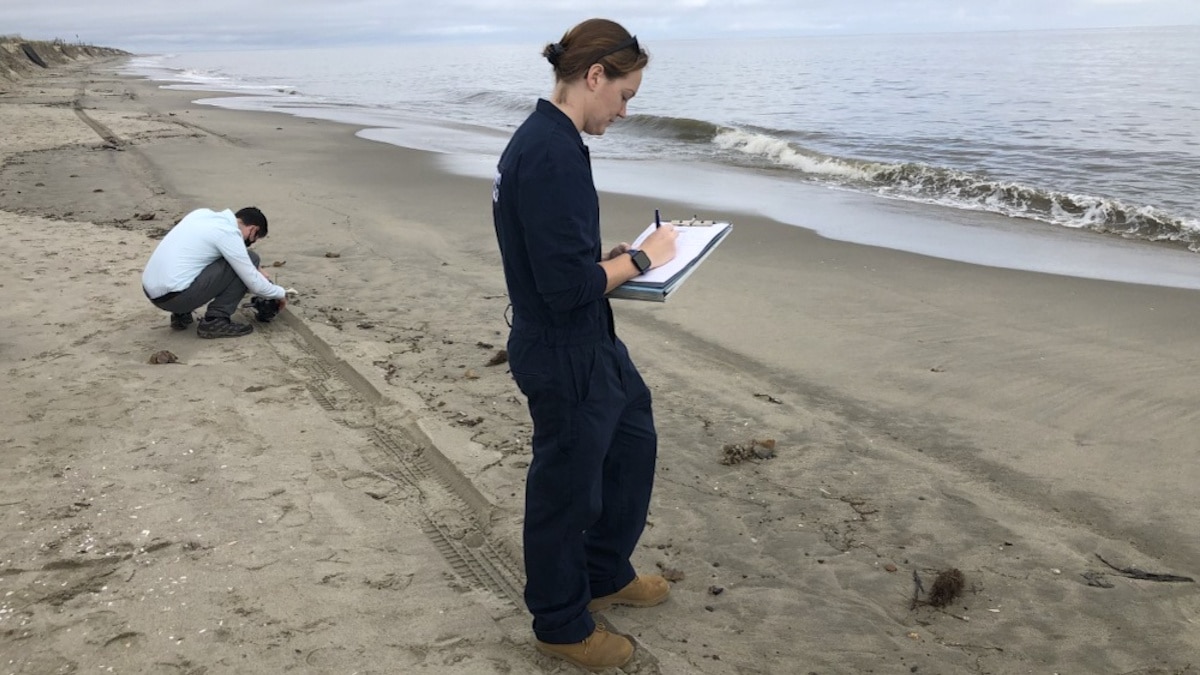

Coast Guard members work to clean an oil spill impacting Delaware beaches. U.S. Coast Guard District 5
Environmental officials and members of the U.S. Coast Guard are racing to clean up a mysterious oil spill that has spread to 11 miles of Delaware coastline.
When the spill was first discovered Monday, it covered only three-fourths of a mile along Broadkill Beach, Delaware Now reported. However, the tides have extended the reach of the oil every day, spreading it along seven miles of Delaware Bay coastline by Tuesday and 11 by Wednesday.
“We are focused on cleanup operations and getting the oil off our beaches and out of our coastal communities as quickly as possible,” Delaware Department of Natural Resources and Environmental Control (DNREC) Secretary Shawn Garvin said in a Wednesday press release. “Expediency is key. We want to capture as much of the oil as we can before it disperses further and causes more environmental harm.”
DNREC is working under unified command with the U.S. Coast Guard to clean the spill, which now extends from Fowler Beach, which borders the Prime Hook National Wildlife Refuge, to Cape Henlopen State Park. It was estimated initially that more than 215 gallons of oil had spilled, but the actual amount may be larger, CBS Philly reported.
The oil line from the spill now extends approximately 11 miles from Fowler Beach bordering Prime Hook National Wildlife Refuge and north of Broadkill Beach, to the ocean side of Cape Henlopen State Park at Gordon's Pond. #netDE pic.twitter.com/Q3e1vGwaGe
— Delaware DNREC (@DelawareDNREC) October 20, 2020
As of Tuesday, recovery efforts had removed around two tons of oily sand and debris, according to DNREC. There are currently more than 75 contractors, DNREC workers and Coast Guard members responding to the spill.
Approximately two tons of oily sand and debris was removed from the affected areas as of 7 p.m., Tuesday. pic.twitter.com/bdCxr8ZNda
— Delaware DNREC (@DelawareDNREC) October 21, 2020
The oil has already impacted some wildlife. Tri-State Bird Rescue and Research had responded to reports of 24 seagulls covered in oil as of Wednesday.
The spill has mostly taken the form of oil patties that range in size from a quarter to a manhole cover, the Coast Guard said Tuesday.
Cape Henlopen park watch volunteer Julie McCall got a first-hand view of the strange black blobs when she was conducting a bird count on Beach Plum Island Monday.
“On the way back, after the tide had gone out quite a bit, I started seeing these bigger patches, and I thought, ‘That looks like oil,'” McCall told WHYY. “Some were bigger than my foot.”
The Coast Guard said it would use the blobs to try and determine the source of the spill.
“Working with our partners at DNREC and state agencies, we will continue to monitor the future potential to the Broadkill Beach area, continue cleanup operations and conduct an investigation to try and determine the source,” Capt. Jonathan Theel, the commanding officer of Sector Delaware Bay, said in a press release.
However, officials think the oil is probably heavy fuel oil that leaked from a vessel, WHYY reported.
McCall said she was worried about how the oil would impact people and animals.
“It’s very scary,” she told WHYY. “Of course, we’re always concerned about the marine animals, and any kind of toxic material in the water. I’m also concerned about birds, any kind of wildlife. A lot of people fish at Beach Plum Island and people walk their dogs and there are kids on the beach. So I’m concerned about exposure to people and animals.”
- Trans Mountain Pipeline Spills up to 50,000 Gallons of Oil on ...
- Citgo Must Pay $143M for a Delaware River Oil Spill, Supreme ...

 233k
233k  41k
41k  Subscribe
Subscribe 